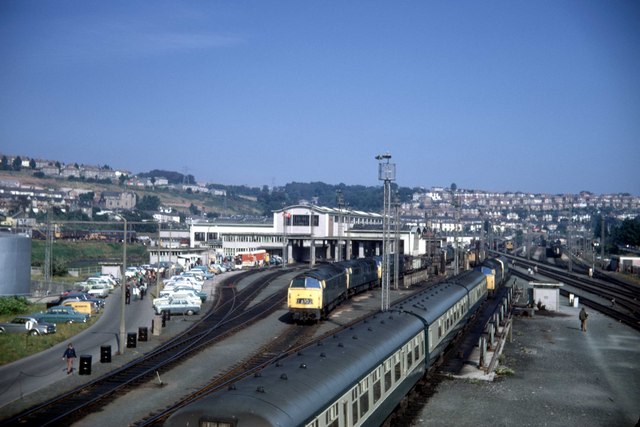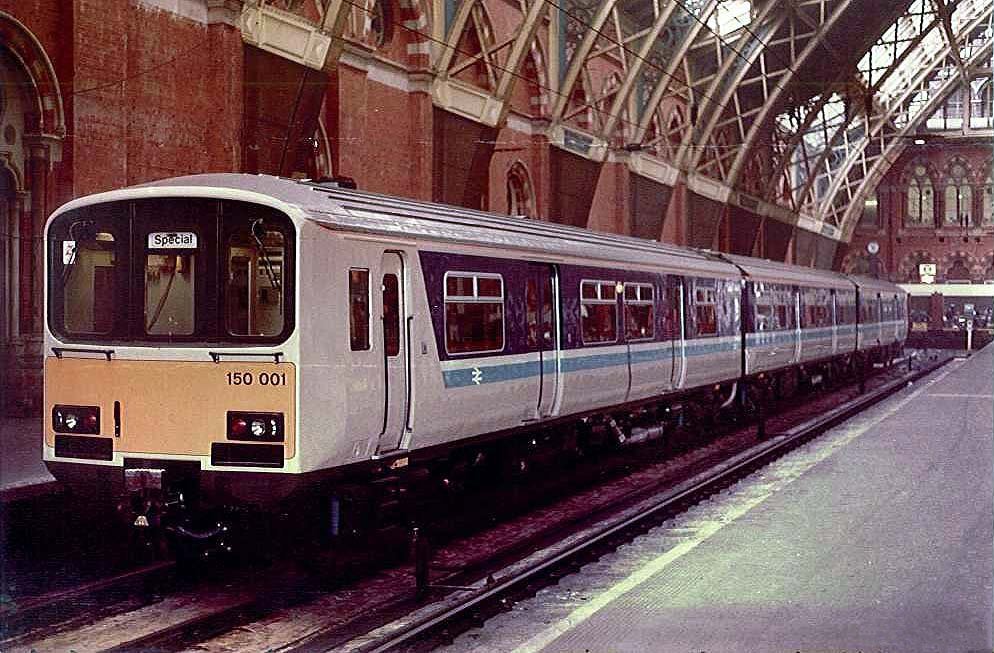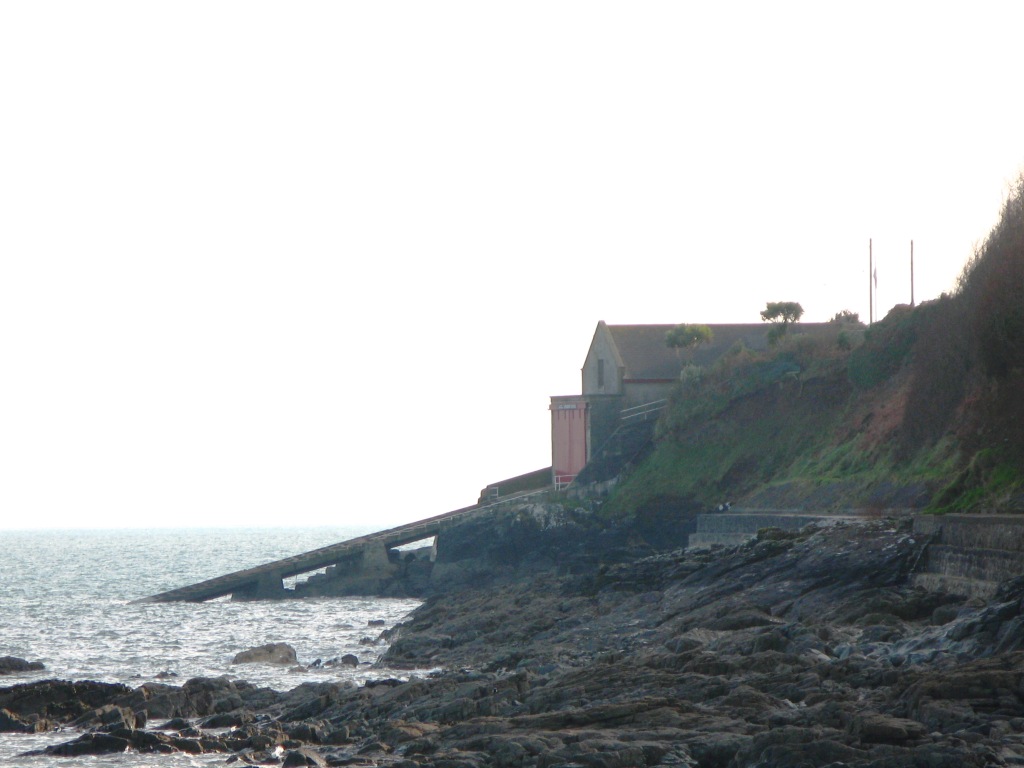|
Penzance TMD
Penzance TMD, also known as Long Rock TMD, is a railway traction maintenance depot situated in the village of Long Rock east of Penzance, Cornwall, England, and is the most westerly and southerly rail depot in the country. The depot operator is Great Western Railway (train operating company), Great Western Railway. The depot code is PZ. Description The depot is beside the Cornish Main Line, where it runs as a single track on the southern side and terminates at Penzance railway station, half a mile west of the depot. The depot is small, with six long sidings to store British Rail Class 253, High Speed Trains and British Rail Class 220, Voyagers, and four smaller sidings. If the longer sidings are all used up, trains are stored at Laira TMD, Plymouth, and then make their way to Penzance railway station in the morning. The depot also has a fuel lane, a single-tracked modern maintenance shed, and a small carriage washer. A few years ago, facilities at Penzance TMD were expanded t ... [...More Info...] [...Related Items...] OR: [Wikipedia] [Google] [Baidu] |
Penzance
Penzance ( ; kw, Pennsans) is a town, civil parish and port in the Penwith district of Cornwall, United Kingdom. It is the most westerly major town in Cornwall and is about west-southwest of Plymouth and west-southwest of London. Situated in the shelter of Mount's Bay, the town faces south-east onto the English Channel, is bordered to the west by the fishing port of Newlyn, to the north by the civil parish of Madron and to the east by the civil parish of Ludgvan. The civil parish includes the town of Newlyn and the villages of Mousehole, Paul, Gulval, and Heamoor. Granted various royal charters from 1512 onwards and incorporated on 9 May 1614, it has a population of 21,200 (2011 census). Penzance's former main street Chapel Street has a number of interesting features, including the Egyptian House, The Admiral Benbow public house (home to a real life 1800s smuggling gang and allegedly the inspiration for ''Treasure Island''s "Admiral Benbow Inn"), the Union Hotel (includi ... [...More Info...] [...Related Items...] OR: [Wikipedia] [Google] [Baidu] |
Laira TMD
Laira T&RSMD is a railway traction and rolling stock maintenance depot situated in Plymouth, Devon, England. The depot is operated by Great Western Railway and is mainly concerned with the overhaul and daily servicing of their fleet of High Speed Trains and also the DMUs used on local services. The depot code "LA" is used to identify rolling stock based there. After sixty years as a steam depot, servicing locomotives used on the Exeter to Plymouth line that runs past the shed as well as local lines, diesels started to arrive in 1958. A diesel depot opened in 1962 and was expanded in 1981 to accommodate the High Speed Trains. History Steam shed Laira was the location of the temporary terminus of the South Devon Railway from 5 May 1848 when a small engine shed would have been provided. With the completion of the line to Plymouth Millbay railway station on 2 April 1849 a new shed was provided there and the facilities at Laira dismantled, although it remained a junction f ... [...More Info...] [...Related Items...] OR: [Wikipedia] [Google] [Baidu] |
British Rail Class 158
The British Rail Class 158 '' Express Sprinter'' is a diesel multiple unit (DMU) passenger train. It is a member of the Sprinter series of regional trains, produced as a replacement for British Rail's first generation of DMUs; of the other members, the Class 159 is almost identical to the Class 158, having been converted from Class 158 to Class 159 in two batches to operate express services from London Waterloo to the West of England. The Class 158 was constructed between 1989 and 1992 by British Rail Engineering Limited (BREL) at its Derby Litchurch Lane Works. The majority were built as two-car sets, some three-car sets were also produced. During September 1990, the first Express Sprinters were operated by ScotRail; the type was promptly introduced to secondary routes across the Midlands, Northern England, Wales and the South West. The Class 158 enabled the replacement of large numbers of elderly DMUs but also several locomotive-hauled trains as well; this was partially a ... [...More Info...] [...Related Items...] OR: [Wikipedia] [Google] [Baidu] |
British Rail Class 150
The British Rail Class 150 ''Sprinter'' is a class of diesel multiple unit passenger trains; they were developed and constructed by BREL York between 1984 and 1987 for use on regional services across the UK. The type is a second-generation design, built to more modern standards and based on BR's Mark 3 body design for longer-distance services. It was developed alongside the lower-cost ''Pacers'', which were built using bus parts, for use on short-distance services. Two prototype units were built, followed by 135 production units in two batches. Subsequently, further members of the Sprinter family were also developed and introduced to service, including the Class 155, Class 156, Class 158 and Class 159. Background By the beginning of the 1980s, British Rail (BR) was operating a large fleet of first-generation DMUs of various designs. While formulating its long-term strategy for this sector of its operations, BR planners recognised that there would be considerable costs ... [...More Info...] [...Related Items...] OR: [Wikipedia] [Google] [Baidu] |
British Rail Mark 3
The British Rail Mark 3 is a type of passenger carriage developed in response to growing competition from airlines and the car in the 1970s. A variant of the Mark 3 became the rolling stock for the High Speed Train (HST). Originally conceived as locomotive-hauled coaching stock, the first coaches built were for the prototype HST in 1972. Production coaches entered service between 1975 and 1988, and multiple-unit designs based on the Mark 3 bodyshell continued to be built until the early 1990s. Most of the surviving fleet of the Mark 3 and its derivatives are still in revenue service on the British railway network in 2020, however, as of 7 April 2021, 300 carriages have been sent for scrap. Introduction File:BR Mk3 12000.jpg, Prototype Mark 3 as delivered File:BR Mk.IIIa TSO No.12014 (6771037103).jpg, Cargo-D Mark 3 in as delivered InterCity livery at Marylebone in June 2008 File:BR Mk.IIIa TSO No.12604 (8074749189).jpg, Chiltern Railways Mark 3 with retrofitted plug doors ... [...More Info...] [...Related Items...] OR: [Wikipedia] [Google] [Baidu] |
Long Rock Sidings - GWR 08410 And Mk3 RFB 10219
Long may refer to: Measurement * Long, characteristic of something of great duration * Long, characteristic of something of great length * Longitude (abbreviation: long.), a geographic coordinate * Longa (music), note value in early music mensural notation Places Asia * Long District, Laos * Long District, Phrae, Thailand * Longjiang (other) or River Long (lit. "dragon river"), one of several rivers in China * Yangtze River or Changjiang (lit. "Long River"), China Elsewhere * Long, Somme, France * Long, Washington, United States People * Long (surname) * Long (surname 龍) (Chinese surname) Fictional characters * Long (''Bloody Roar''), in the video game series Sports * Long, a fielding term in cricket * Long, in tennis and similar games, beyond the service line during a serve and beyond the baseline during play Other uses * , a U.S. Navy ship name * Long (finance), a position in finance, especially stock markets * Lòng, name for a laneway in Shanghai * Long in ... [...More Info...] [...Related Items...] OR: [Wikipedia] [Google] [Baidu] |
Royal National Lifeboat Institution
The Royal National Lifeboat Institution (RNLI) is the largest charity that saves lives at sea around the coasts of the United Kingdom, the Republic of Ireland, the Channel Islands, and the Isle of Man, as well as on some inland waterways. It is one of Independent lifeboats in Britain and Ireland, several lifeboat services operating in the same area. Founded in 1824 as the National Institution for the Preservation of Life from Shipwreck, soon afterwards becoming the Royal National Institution for the Preservation of Life from Shipwreck, under the patronage of King George IV. On 5 October 1854, the institution’s name was changed to its current name (RNLI), and in 1860 was granted a royal charter. The RNLI is a charity in the UK and in the Republic of Ireland and has enjoyed royal patronage since its foundation, the most recent being Elizabeth II of the United Kingdom, Queen Elizabeth II until her death on 8 September 2022. The RNLI is principally funded by Will (law), legacie ... [...More Info...] [...Related Items...] OR: [Wikipedia] [Google] [Baidu] |
Penlee Lifeboat Station
Penlee Lifeboat Station is the base for Royal National Lifeboat Institution (RNLI) search and rescue operations for Mount's Bay in Cornwall, United Kingdom. The lifeboat station operated at various locations in Penzance from the early 19th century. It moved to Penlee Point near Mousehole in 1913, thus gaining its current name, but was moved to Newlyn in 1983 without any change of name. The station is remembered for the loss of the entire lifeboat crew on 19 December 1981. Since 2003 the station has operated a all weather boat (ALB) and an ''Atlantic''-class (currently an ) inshore lifeboat (ILB). The lifeboat has an operating range of and a top speed of , enabling it to reach any casualty up to , and within two hours in good weather. Adjacent lifeboats are at to the east, and to the west. History Early locations The first lifeboat in Cornwall was purchased for Penzance in 1803. Part of its cost was paid by Lloyd's of London but it was sold, in 1812, without ever being us ... [...More Info...] [...Related Items...] OR: [Wikipedia] [Google] [Baidu] |
Night Riviera
The ''Night Riviera'' is a sleeper train operated by Great Western Railway (GWR). It is one of only two sleeper services on the railway in the United Kingdom (the other being the ''Caledonian Sleeper'' services between London and Scotland). The ''Night Riviera'' runs six nights a week (Sunday–Friday) between London Paddington and Penzance with one train in each direction. Background The first sleeping car train on the Great Western Railway was introduced at the end of 1877 from London Paddington to Plymouth. This had broad gauge carriages with two dormitories, one with seven gentlemen's berths and the other with four ladies’ berths. These were replaced in 1881 by new carriages with six individual compartments. An additional service was soon added from London to Penzance which eventually became known as the ''Night Riviera''. In 1920, the two trains left London at 22:00 for Penzance and midnight for Plymouth; by 1947, they had been brought forward to 21:50 and 23:50. Und ... [...More Info...] [...Related Items...] OR: [Wikipedia] [Google] [Baidu] |
British Rail Class 43 (HST)
The British Rail Class 43 (HST) is the TOPS classification used for the InterCity 125 ''High Speed Train'' (formerly Classes British Rail Class 253, 253 and British Rail Class 254, 254) power cars, built by British Rail Engineering Limited from 1975 to 1982, and in service in the UK since 1976. The class is officially the Railway speed record#Fuel-electric, fastest diesel locomotive in the world, with an absolute maximum speed of , and a regular service speed of . The record run was led by 43102 (43302) and trailed by 43159. History and background In the early 1970s, the British Railways Board made the decision to replace its main-line express diesel traction. Financial limitations were tight, so mass electrification was not possible. As a result, a new generation of high-speed diesel trains had to be developed. Experience with the high-speed British Rail Class 55, Class 55 ''Deltic'' locomotives had shown that a low axle weight was essential to avoid damage to the track at ... [...More Info...] [...Related Items...] OR: [Wikipedia] [Google] [Baidu] |
British Rail
British Railways (BR), which from 1965 traded as British Rail, was a state-owned company that operated most of the overground rail transport in Great Britain from 1948 to 1997. It was formed from the nationalisation of the Big Four British railway companies, and was privatised in stages between 1994 and 1997. Originally a trading brand of the Railway Executive of the British Transport Commission, it became an independent statutory corporation in January 1963, when it was formally renamed the British Railways Board. The period of nationalisation saw sweeping changes in the railway. A process of dieselisation and electrification took place, and by 1968 steam locomotives had been entirely replaced by diesel and electric traction, except for the Vale of Rheidol Railway (a narrow-gauge tourist line). Passengers replaced freight as the main source of business, and one-third of the network was closed by the Beeching cuts of the 1960s in an effort to reduce rail subsidies. On privatis ... [...More Info...] [...Related Items...] OR: [Wikipedia] [Google] [Baidu] |
Penzance TRSD - GWR 57604
Penzance ( ; kw, Pennsans) is a town, civil parish and port in the Penwith district of Cornwall, United Kingdom. It is the most westerly major town in Cornwall and is about west-southwest of Plymouth and west-southwest of London. Situated in the shelter of Mount's Bay, the town faces south-east onto the English Channel, is bordered to the west by the fishing port of Newlyn, to the north by the civil parish of Madron and to the east by the civil parish of Ludgvan. The civil parish includes the town of Newlyn and the villages of Mousehole, Paul, Gulval, and Heamoor. Granted various royal charters from 1512 onwards and incorporated on 9 May 1614, it has a population of 21,200 (2011 census). Penzance's former main street Chapel Street has a number of interesting features, including the Egyptian House, The Admiral Benbow public house (home to a real life 1800s smuggling gang and allegedly the inspiration for ''Treasure Island''s "Admiral Benbow Inn"), the Union Hotel (includin ... [...More Info...] [...Related Items...] OR: [Wikipedia] [Google] [Baidu] |







.jpg)